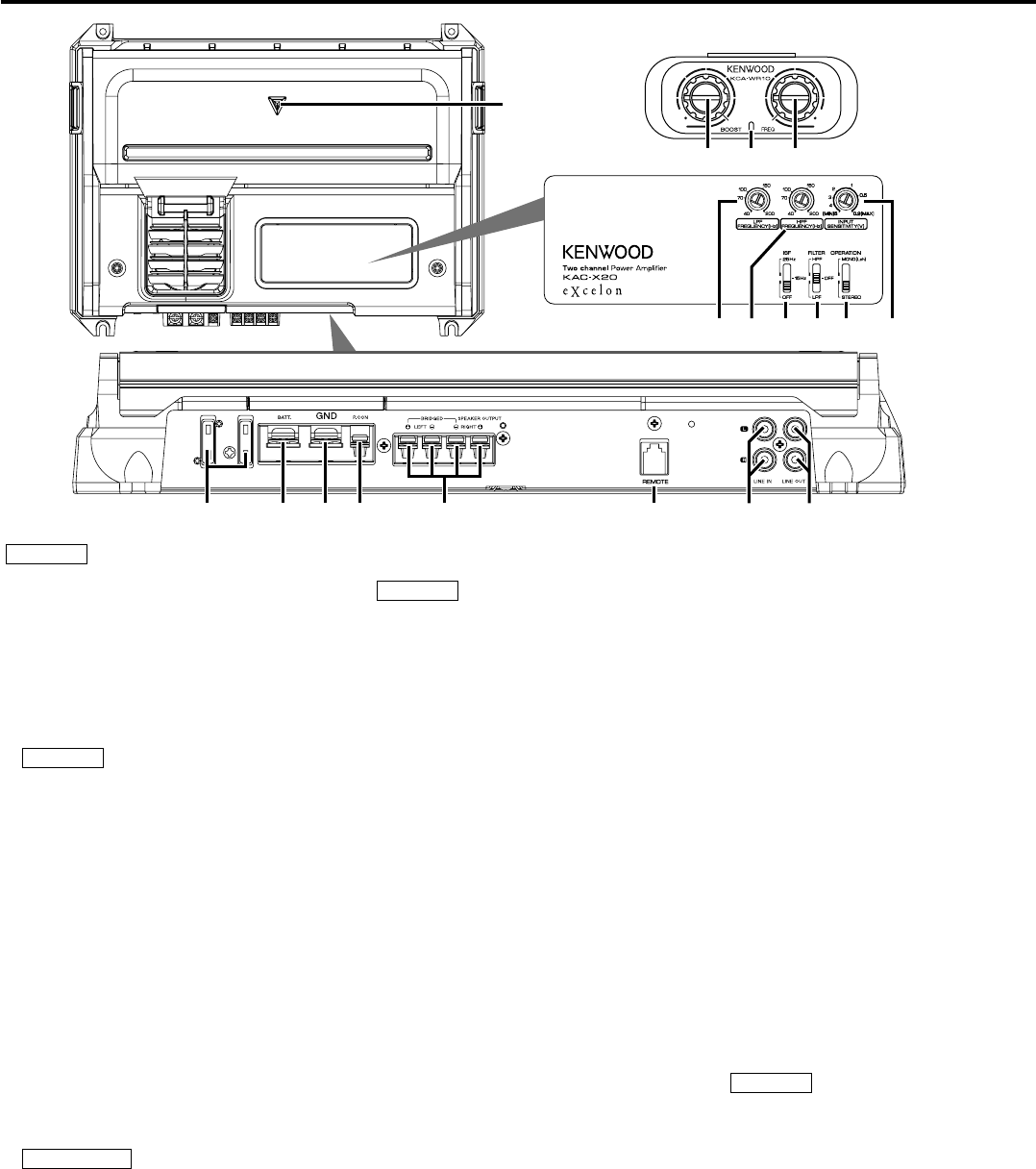
English 5
Controls
NOTE
The control panel locates under the dressing
cover. Remove the cover to access to its controls
for adjustment. (See page 3)
1 Fuse (30 A × 2)
2 Battery terminal
3 Ground terminal
4 Power control terminal
Controls the unit ON/OFF.
NOTE
Controls the unit power. Be sure to connect it
with all the systems.
5 Speaker output terminals
• Stereo Connections:
When you wish to use the unit as a stereo
amplifier, stereo connections are used.
The speakers to be connected should have an
impedance of 2 or greater. When multiple
speakers are to be connected, ensure that the
combined impedance is 2 or greater for each
channel.
• Bridged Connections:
When you wish to use the unit as a high-output
monaural amplifier, bridged connections are
used. (Make connections to the LEFT channel
9 and the RIGHT channel · SPEAKER OUTPUT
terminals.)
The speakers to be connected should have an
impedance of 4 or greater. When multiple
speakers are to be connected, ensure that the
combined impedance is 4 or greater.
2CAUTION
The rated input of the speakers should be no
less than the maximum output of the amplifier.
Otherwise malfunction may result.
6 REMOTE terminal
Connects the Remote cable.
NOTE
Use the Remote cable of the accessory.
7 LINE IN terminal
8 LINE OUT terminal
The signal that’s input from the line input
terminal is output.
9 Power indicator
When the power is turned on, the Power
indicator lights.
If the Power indicator does not light when the
power is turned on, the protection function
may be activated. Check whether there is any
indication of trouble. (See page 2)
0 LPF FREQUENCY control
Sets the cutoff frequency when the "FILTER"
switch is set to "LPF".
! HPF FREQUENCY control
Sets the cutoff frequency when the "FILTER"
switch is set to "HPF".
@ ISF (infrasonic filter) switch
Ultralow frequencies that cannot be reproduced
even by a subwoofer speaker do not become
sound but become unnecessary oscillations,
which affect the sound by causing distortion, etc.
Setting this switch to "15 Hz" or "25 Hz" cuts the
frequencies below the respective frequency.
This improves the reproduction performance
of the speakers by eliminating unnecessary
oscillations which will not become sound.
# FILTER switch
This switch allows to apply high-pass or low-pass
filtering to the speaker outputs.
• HPF (High-Pass Filter) position:
The filter outputs the band of higher
frequencies than the frequency set with the
"HPF FREQUENCY" control.
• OFF position:
The entire bandwidth is output without
filtering.
• LPF (Low-Pass Filter) position:
The filter outputs the band of lower frequencies
than the frequency set with the "LPF
FREQUENCY" control.
The speaker output is automatically switched to
monaural (L+R).
$ OPERATION switch
This switch is used to select the operation mode
of the amplifier.
• STEREO position:
The amplifier can be used as a stereo amplifier.
• MONO (Lch) position:
Amplifies the signal input from the left side
only. Set to this position and make bridged
connections to use as a high-power monaural
amplifier. (The input right signal is not output.)
% INPUT SENSITIVITY control
Set this control according to the pre-output level
of the center unit connected with this unit.
NOTE
For the pre-output level, refer to the
<Specifications> in the instruction manual of the
center unit.
^ BOOST LEVEL (Bass boost level) control
Sets the level by which the low frequency range
should be boosted.
& Power indicator
* FREQUENCY (Bass boost frequency)
control
Sets the center frequency around which the low
frequency range should be boosted.
POWER IN
30
30
FUSE(30As2)
~|
}
vuw
x
y
strqp
{z
Remote controller (Optional accessory)


















